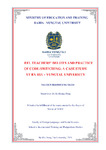Please use this identifier to cite or link to this item:
http://thuvienso.bvu.edu.vn/handle/TVDHBRVT/20547Full metadata record
| DC Field | Value | Language |
|---|---|---|
| dc.contributor.advisor | Le, Hoang Dung (GVHD) | - |
| dc.contributor.author | Nguyen, Thi Phuong Thao | - |
| dc.date.accessioned | 2022-08-04T01:48:44Z | - |
| dc.date.available | 2022-08-04T01:48:44Z | - |
| dc.date.issued | 2021 | - |
| dc.identifier.uri | http://thuvienso.bvu.edu.vn/handle/TVDHBRVT/20547 | - |
| dc.description.abstract | This study explores the practice, including the forms and functions, and beliefs of code-switching practiced by EFL teachers in classroom instruction in the Vietnamese University context. Some research in this field conducted around the world highlighted some noticeable theories. In the education context, many techniques, conclusions, and ideas of Vietnamese University professors' code switching practice have been contributed by various significant research. Furthermore, there have been few studies in the Vietnamese setting that compare the similarities and differences between instructors' views on code-switching and their actual practice of code-switching in teaching, research on the practice of code-switching should be done at every school and university with various external components. For the context, this study was conducted at Ba Ria – Vung Tau University (BVU) with the participation of 9 EFL teachers and 59 students in teacher participants’ classes. Data collecting stages were conducted using four major sources of data: classroom observations, questionnaires for both teachers and students, and interviews with the observed teachers. The Findings show that teachers practiced codeswitching very often in their teaching process for 19 different functions. Among the functions found in the study, several appeared more or less than other previous ones. Codeswitching was also presented under 4 forms in this study. Three forms found in the previous studies, including inter-sentential, intra-sentential, and tag/fill/extra-sentential, appeared in this study and one new form of codeswitching named ‘Single Switching’ by the researcher also found in this study. Also shown in the findings for the similarity and differences between teachers’ beliefs and practice of codeswitching, teachers’ belief have influenced significantly their practice of codeswitching. Teachers with positive support toward employing codeswitching had most times practice codeswitching in their teaching process and vice versa. However, several teachers with unsupportive attitudes toward codeswitching, in some teaching stages or skills, employed more codeswitching than they thought with pedagogy purpose or unintentional. | vi |
| dc.language.iso | en | vi |
| dc.publisher | Trường Đại học Bà Rịa - Vũng Tàu | vi |
| dc.subject | English language -- Study and teaching -- Master's thesis report | vi |
| dc.subject | Anh ngữ -- Học tập và giảng dạy -- Luận văn Thạc sĩ | vi |
| dc.title | EFL teachers' beliefs and practice of code-switching: a case study at Ba Ria - Vung Tau University: Master of TESOL | vi |
| dc.type | Thesis | vi |
| Appears in Collections: | Luận văn ngành Ngôn ngữ Anh | |
Files in This Item:
| File | Description | Size | Format | |
|---|---|---|---|---|
| Nguyen-Thi-Phuong-Thao.pdf | 5,53 MB | Adobe PDF |  Sign in to read |
Items in DSpace are protected by copyright, with all rights reserved, unless otherwise indicated.